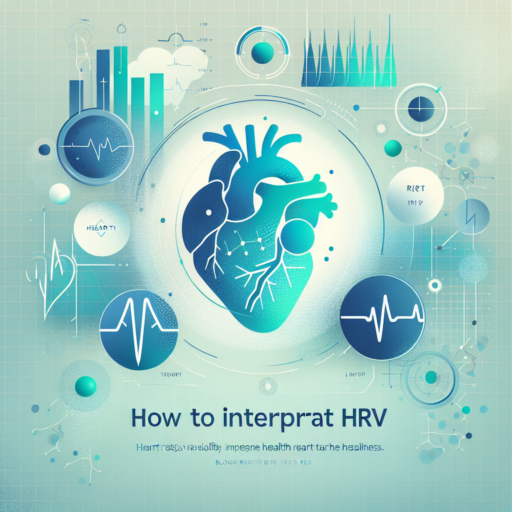Understanding the Basics of Heart Rate Variability (HRV)
Heart Rate Variability (HRV) is a measure of the variation in time between each heartbeat. This metric is considered a key indicator of the autonomic nervous system’s function and overall heart health. Unlike the heart rate, which might indicate how fast the heart is beating, HRV focuses on the timing variation between successive heartbeats. A higher HRV suggests a more adaptable cardiovascular system, capable of efficiently managing stress, recovery, and physical exertion levels.
The value of HRV as a health and wellness indicator has gained significant traction in recent years. It’s rooted in the belief that a higher variability signals a healthy balance between the sympathetic (fight or flight) and parasympathetic (rest and digest) branches of the nervous system. This balance is crucial for maintaining a state of homeostasis within the body, allowing for a flexible response to internal and external stressors without overtaxing the system.
To understand and monitor HRV, various wearable devices and mobile applications have become available, making it accessible not only to athletes and fitness enthusiasts but also to the general public. These tools provide valuable insights into how lifestyle choices—like diet, exercise, stress management, and sleep quality—affect one’s overall health and wellbeing. Consequently, by observing the patterns and trends in their HRV data, individuals can make informed decisions to optimize their health and performance.
The Importance of HRV for Your Health and Fitness
Understanding the Heart Rate Variability (HRV) has become increasingly important for those looking to optimize their health and fitness. HRV is the measure of the variation in time between each heartbeat, a critical marker not just of your cardiac health but your overall well-being and fitness levels. This metric offers insights beyond basic heart rate metrics, revealing the nuanced ways in which your body responds to stress, exercise, and rest.
Enhanced Athletic Performance
For athletes and fitness enthusiasts, HRV is a vital tool in customizing training programs. It helps in identifying periods of overtraining or under-recovery, thereby allowing adjustments that can lead to enhanced performance. By monitoring HRV, individuals can optimize their workout intensity and recovery times, ensuring they are training in a manner that is conducive to their body’s needs without risking injury or burnout.
Stress Management and Recovery
HRV is also an invaluable metric for stress management. A higher HRV indicates a healthy, responsive autonomic nervous system, suggesting your body is better able to cope with stressors. Conversely, a lower HRV is associated with stress, fatigue, and even poor sleep quality. Regularly tracking HRV can therefore provide critical insights into your body’s stress levels and recovery status, enabling you to take proactive steps towards managing stress and optimizing recovery.
Step-by-Step Guide to Interpreting HRV Data
Understanding Heart Rate Variability (HRV) data can transform your approach to stress management and wellness. HRV measures the variation in time between each heartbeat, a key indicator of your autonomic nervous system’s balance and your body’s resilience to stress. This guide will walk you through a basic interpretation of HRV data, helping you make more informed health decisions.
1. Establish Your Baseline
Before diving into daily HRV analysis, it’s essential to establish your baseline HRV. This involves measuring your HRV at a consistent time, preferably right after waking up, over a period of 4-6 weeks. Use a reliable HRV monitoring tool and record your data daily to understand your average HRV score. Knowing your baseline will make it easier to notice any significant deviations indicating stress, illness, or overtraining.
2. Look for Patterns and Trends
Once you have your baseline, tracking daily changes can provide insights into your body’s response to various stressors. An increasing HRV trend over time may suggest improvements in fitness levels or stress management strategies. Conversely, a consistent decline in your HRV could signal overtraining, poor recovery, or accumulating stress. Keeping an eye on long-term trends is more informative than fixating on day-to-day fluctuations, which can be influenced by numerous factors like diet, sleep, and even hydration levels.
3. Interpret the Context
Interpreting HRV data requires considering the context of your life. Sudden drops in HRV might be related to stress, illness, or even alcohol consumption the night before. High-intensity training sessions can also lead to temporary decreases in HRV, reflecting the body’s need to recover. By correlating changes in your HRV with lifestyle factors, you can start identifying what positively or negatively affects your HRV, enabling you to make adjustments for optimal health and performance.
No se han encontrado productos.
Tools and Apps to Measure Your HRV
Heart Rate Variability (HRV) has become a key metric for assessing overall health, stress levels, and resilience. With the rise of wearable technology and health apps, measuring your HRV has never been easier. In this segment, we’ll explore popular tools and apps that empower users to track their HRV effectively and conveniently, shedding light on functionalities that make them stand out in the digital health arena.
Featured Wearables for HRV Tracking
Wearable technology has revolutionized the way we monitor our health, offering real-time data at our fingertips. Leading the pack in HRV measurement are smartwatches and fitness trackers from brands like Apple, Fitbit, and Garmin. These devices boast advanced sensors that capture heart rate data to calculate HRV scores, presenting insights into stress management, workout recovery, and even sleep quality. The integration of HRV tracking into these wearables makes it incredibly accessible for anyone looking to optimize their health routines.
Top Smartphone Apps for HRV Analysis
In addition to wearable tech, smartphone apps have become a go-to source for HRV analysis, offering a wide range of functionalities from basic tracking to comprehensive wellness recommendations. Apps such as Elite HRV and HRV4Training allow users to measure their HRV using just the phone’s camera or in tandem with a compatible heart rate monitor. These apps not only track your daily HRV trends but also provide personalized advice on exercise, recovery, and stress management based on your HRV patterns. Their user-friendly interfaces and valuable insights make them indispensable tools in the pursuit of optimal health.
Understanding your HRV can unlock new dimensions of health awareness, guiding you towards lifestyle adjustments that foster wellbeing and performance. Whether you prefer the comprehensive approach of wearable tech or the simplicity and convenience of smartphone apps, there’s a plethora of options available to help you integrate HRV tracking into your health regimen.
How to Improve Your HRV: Tips and Strategies
Understanding and improving your Heart Rate Variability (HRV) can be a vital part of enhancing your overall wellness and resilience to stress. As an intricate measure of the variations in time between each heartbeat, a higher HRV is often associated with better cardiovascular fitness, stress management, and autonomic nervous system balance. Below are some practical tips and strategies to help elevate your HRV.
Consistent Physical Activity
Engaging in regular, consistent exercise is one of the most effective ways to improve your HRV. Aim for a mix of cardiovascular exercises, strength training, and flexibility workouts to enhance your heart’s efficiency and resilience. Moderate intensity exercises, such as brisk walking, cycling, or swimming, performed for at least 150 minutes per week, are highly recommended to see a significant impact on your HRV.
Stress Reduction Techniques
Stress plays a substantial role in affecting your HRV negatively. Implementing stress reduction techniques such as mindfulness meditation, yoga, or deep breathing exercises can help mitigate the impact of stress on your body. These practices not only aid in reducing your stress levels but also enhance your HRV by promoting relaxation and improving your autonomic nervous system’s balance.
Optimize Your Sleep
Quality sleep is crucial for a healthy HRV as it aids in the recovery and rejuvenation of your heart. Prioritizing 7-9 hours of uninterrupted sleep and maintaining a consistent sleep schedule can positively influence your HRV. Consider adopting sleep hygiene practices such as reducing exposure to blue light before bedtime, ensuring a comfortable sleep environment, and avoiding caffeine or heavy meals close to bedtime to optimize your sleep quality.
Interpreting HRV Scores: What’s Normal and What’s Not
Understanding your Heart Rate Variability (HRV) score is crucial in deciphering the state of your overall wellness and fitness. HRV measures the variation in time between each heartbeat, which is directly linked to your autonomic nervous system’s (ANS) performance. This system controls your body’s involuntary functions, and a higher HRV score typically suggests better cardiovascular fitness, stress resilience, and overall health. However, comprehending what constitutes a «normal» HRV score can be complex, as it varies significantly among individuals.
Factors Influencing HRV Scores include age, gender, fitness level, lifestyle habits, and stress levels. Generally, a HRV score can range widely across different age groups and fitness levels. Athletes, for instance, often have higher HRV scores than non-athletes, indicating their hearts can efficiently manage variations in stress and activity levels. On the contrary, lower HRV scores might signify stress, overtraining, or potential health issues. It’s imperative to consider these factors when assessing your score to understand your body’s signals accurately.
Furthermore, monitoring your HRV over time provides the most value. Observing trends in your HRV scores, rather than fixating on a single measurement, can offer insightful indicators about your health and fitness progress. An increasing trend over time suggests improvements in stress management, recovery, and overall autonomic function, while a declining trend might indicate a need to assess potential stressors or recuperation practices. Understanding these patterns is key to leveraging HRV as a powerful tool in managing and optimizing your health and wellness routine.
The Role of HRV in Stress Management and Recovery
Understanding the role of Heart Rate Variability (HRV) in stress management and recovery is essential for anyone looking to improve their physical and emotional well-being. HRV measures the time variation between heartbeats and serves as a critical indicator of our nervous system’s flexibility in responding to stress. This metric has gained prominence for its potential to offer a real-time snapshot of our body’s stress levels and recovery state.
Enhancing Stress Resilience: HRV is directly linked to our body’s stress resilience. High HRV levels indicate a robust ability to handle stress, as they reflect a well-functioning parasympathetic nervous system—the aspect of our nervous system responsible for relaxation and recovery. By monitoring HRV, individuals can adjust their lifestyle choices to enhance their stress resilience, ultimately contributing to better stress management and recovery.
Optimizing Recovery: In the realm of physical and emotional well-being, recovery is just as important as the stressor itself. A high HRV suggests not only a body well-prepared for stress but also one that can efficiently recover from it. Techniques aimed at improving HRV, such as mindfulness practices, controlled breathing, and regular physical activity, can significantly optimize the body’s recovery process. These practices help in shifting the balance towards a more relaxed state, facilitating quicker recovery from stress-induced fatigue and preventing burnout.
Case Studies: Success Stories of Improving Health Through HRV Insights
The exploration of Heart Rate Variability (HRV) as a tool to enhance well-being and promote health advancement has yielded numerous success stories. By closely monitoring HRV metrics, individuals and healthcare professionals are unlocking profound insights into the body’s stress and recovery states. This offers a detailed picture of overall health and provides actionable guidance for improvement. The following narratives spotlight the transformative power of HRV insights in various health journeys.
Enhancing Athletic Performance through HRV Monitoring
One standout case is that of a competitive athlete who leveraged HRV data to fine-tune their training regimen. By observing fluctuations in HRV, the athlete identified patterns of overtraining and insufficient recovery, which had previously led to plateaus and injuries. With targeted adjustments based on HRV insights, they achieved remarkable improvements in performance, demonstrating HRV’s critical role in sports science and athletic preparation.
Recovery and Stress Management for High-Performing Professionals
High-performing professionals, often juggling intense workloads and high stress, have also benefitted from HRV monitoring. A case involved an executive facing burnout due to chronic stress. Through HRV-based insights, they implemented routine changes that significantly enhanced their well-being. This included stress-reduction techniques and improved sleep patterns, leading to increased resilience and a better work-life balance. The HRV data acted as a crucial early warning system, indicating when to intensify recovery practices to avert potential health downturns.
These stories underline the impact of HRV insights on health optimization. By providing a granular view of the body’s physiological responses, individuals are empowered to make informed decisions that foster health and well-being. Whether for athletes seeking peak performance or professionals managing stress, HRV offers a pathway to enhanced health outcomes.
FAQs: Answers to Common Questions About HRV Interpretation
Interpreting Heart Rate Variability (HRV) can be complex, with many individuals seeking clarity on what their metrics indicate about their health and fitness levels. Below, we address some of the most common questions related to HRV interpretation, offering insights to help you better understand this valuable health metric.
What Does a High HRV Score Mean?
A high HRV score generally indicates a healthy, responsive cardiovascular system. It reflects the ability of the heart to adapt to varying stress levels and demands, signifying greater resilience and flexibility in the body’s autonomic nervous system. However, context is key, and factors such as age, fitness level, and overall health status should also be considered when interpreting HRV scores.
Can Daily Activities Affect HRV?
Yes, daily activities and lifestyle choices have a significant impact on HRV. For example, physical exercise typically increases HRV in the long term, whereas stress, poor sleep quality, and unhealthy dietary habits can lower it. Monitoring HRV can provide valuable feedback on how your body responds to different stressors and help guide lifestyle adjustments.
How Can I Improve My HRV?
Improving HRV involves a combination of consistent physical activity, stress management techniques, adequate sleep, and a balanced diet. Incorporating mindfulness practices like meditation and yoga can also effectively enhance HRV. Regular, moderate-to-vigorous exercise is particularly beneficial, as it improves heart health and increases autonomic nervous system adaptability.




